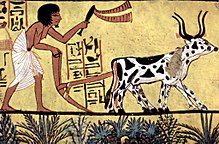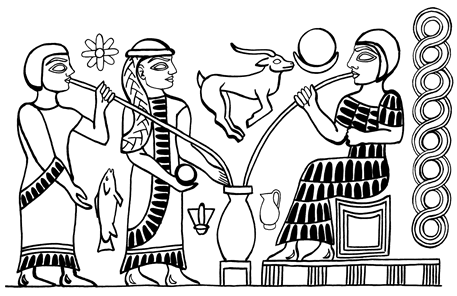Biotechnology (sometimes shortened to "biotech") is the use of living systems and organisms to develop or make useful products. While thousands of years, humankind has used biotechnology in agriculture, food production and medicine. Agriculture has been theorized to have become the dominant way of producing food since the Neolithic Revolution.
 Through early biotechnology, the earliest farmers selected and bred the best suited crops, having the highest yields, to produce enough food to support a growing population. As crops and fields became increasingly large and difficult to maintain, it was discovered that specific organisms and their by-products could effectively fertilize, restore nitrogen, and control pests. Throughout the history of agriculture, farmers have inadvertently altered the genetics of their crops through introducing them to new environments and breeding them with other plants one of the first forms of biotechnology.
Through early biotechnology, the earliest farmers selected and bred the best suited crops, having the highest yields, to produce enough food to support a growing population. As crops and fields became increasingly large and difficult to maintain, it was discovered that specific organisms and their by-products could effectively fertilize, restore nitrogen, and control pests. Throughout the history of agriculture, farmers have inadvertently altered the genetics of their crops through introducing them to new environments and breeding them with other plants one of the first forms of biotechnology.
These processes also were included in early fermentation of beer. These processes were introduced in early Mesopotamia, Egypt, and India, and still use the same basic biological methods. In brewing, malted grains (containing enzymes) convert starch from grains into sugar and then adding specific yeasts to produce beer. In this process, carbohydrates in the grains were broken down into alcohols such as ethanol. Later other cultures produced the process of lactic acid fermentation which allowed the fermentation and preservation of other forms of food, such as soy sauce. Fermentation was also used in this time period to produce leavened bread. Although the process of fermentation was not fully understood until Louis Pasteur's work in 1857, it is still the first use of biotechnology to convert a food source into another form. For thousands of years, humans have used selective breeding to improve production of crops and livestock to use them for food. In selective breeding, organisms with desirable characteristics are mated to produce offspring with the same characteristics. For example, this technique was used with corn to produce the largest and sweetest crops.
In the early twentieth century scientists gained a greater understanding of microbiology and explored ways of manufacturing specific products. In 1917, Chaim Weizmann first used a pure microbiological culture in an industrial process, that of manufacturing corn starch using Clostridium acetobutylicum, to produce acetone, which the United Kingdom desperately needed to manufacture explosives during World War I.
Biotechnology has also led to the development of antibiotics. In 1928, Alexander Fleming discovered the mold Penicillium. His work led to the purification of the antibiotic by Howard Florey, Ernst Boris Chain and Norman Heatley, penicillin. In 1940, penicillin became available for medicinal use to treat bacterial infections in humans.
The field of modern biotechnology is generally thought of as having been born in 1971 when Paul Berg's (Stanford) experiments in gene splicing had early success.
Herbert W. Boyer (Univ. Calif. at San Francisco) and Stanley N. Cohen (Stanford) significantly advanced the new technology in 1972 by transferring genetic material into a bacterium, such that the imported material would be reproduced.
United States Supreme Court ruled that a genetically modified microorganism could be patented in the case of Diamond v. Chakrabarty. Indian-born Ananda Chakrabarty, working for General Electric, had modified a bacterium (of the Pseudomonas genus) capable of breaking down crude oil, which he proposed to use in treating oil spills. (Chakrabarty's work did not involve gene manipulation but rather the transfer of entire organelles between strains of the Pseudomonas bacterium.
The biotechnology sector has allowed the U.S. farming industry to rapidly increase its supply of corn and soybeans—the main inputs into biofuels—by developing genetically modified seeds which are resistant to pests and drought. By boosting farm productivity, biotechnology plays a crucial role in ensuring that biofuel production targets are met.
Rising demand for biofuels is expected to be good news for the biotechnology sector, with the Department of Energy estimating ethanol usage could reduce U.S. petroleum-derived fuel consumption by up to 30% by 2030.
Biotechnology is currently being used in many areas including agriculture, bioremediation, food processing, and energy production. DNA fingerprinting is becoming a common practice in forensics.
One interesting avenue of biotechnology is utilizing a virus to create a new type of tiny battery, made with a simple stamping technique, that could power miniature devices.
Electronic devices used for controlled drug delivery, or to power tiny lab-on-a-chipapplications, need to get their power from somewhere. But as conventional batteries are made smaller and smaller, they contain less and less of the materials that actually store charge, causing a decline in efficiency.
Using nanoscale components can boost a battery's capacity to store charge. Now, scientists at the Massachusetts Institute of Technology, Cambridge, have designed a quick method to build a microbattery that relies on a genetically-engineered virus called M13. The scientists first made a template from polydimethylsiloxane (PDMS), a commonly used silicon-based organic polymer. After coating it with alternating layers of positive and negative electrolytes, they added the virus.
The virus had been designed to have negatively charged amino acids at its surface, so that it stuck to the template, and an affinity for cobalt -a favoured material for batteries. Each virus is a semi-rigid fibre a few nanometres in diameter and about a micrometre long, which tends to pack tightly into a whorl that looks similar to a fingerprint. The whole assembly was dipped into a solution of cobalt ions, which coated the viruses to create a very large surface area that could store charge. Stamping the template onto a platinum layer and peeling off the PDMS left behind an array of small dots of the prepared material, cobalt-side down, which formed the heart of an effective battery. The work is published in the Proceedings of the National Academy of Sciences.
"This is the first time anyone has ever stamped a battery device," says Paula Hammond, part of the MIT team.
Biotechnology has reached to a point whereby nano technology are utilizing natural biological systems to function new ways. Optimizing plants for food growth and biofuels as well as new cloning techniques and possible personalized medicines for gene specific diseases. The unlimited potential to design a system using natural resources could pave way to a better life. On the other hand it is likely that trial and error on certain biological systems might make things worse. As with certain mislabel issues have contaminated genetically modified corn intended for biofuels was used in human consumption. And the World Wide Fund for Nature (WWF) says more than 350 man-made pollutants have been identified in the breast milk of women in the UK.The resulting scares that natural foods isn't natural any more. Not doubt advances in biotechnology will bring on some ethical issues and that people will gravitate towards the cheap synthetic option. The end result is a future towards intelligent biological design on everything, the fallout could be horrid mutations and unforeseen consequences...








No comments:
Post a Comment